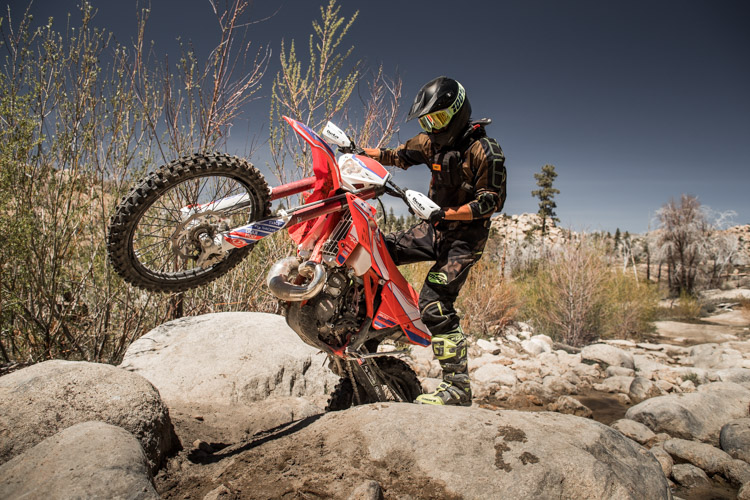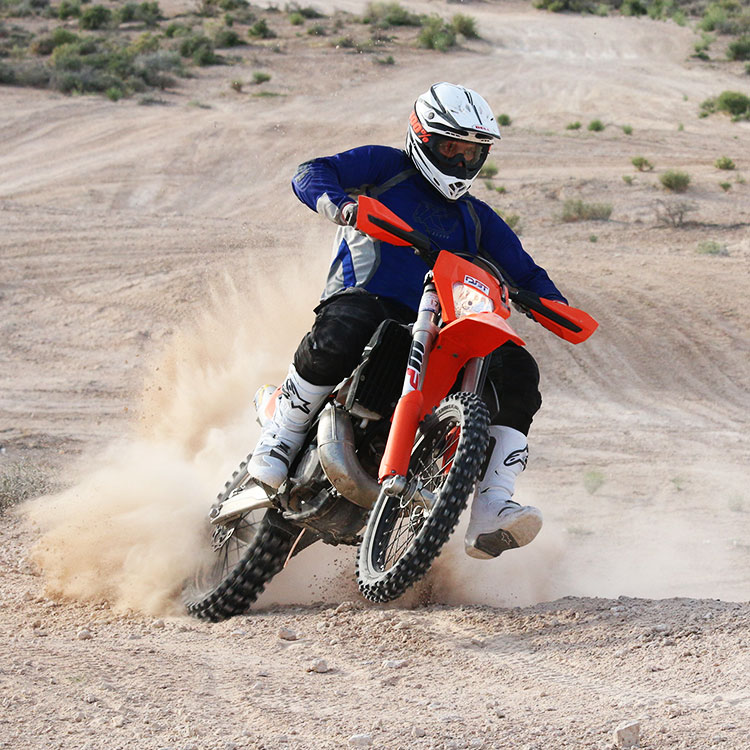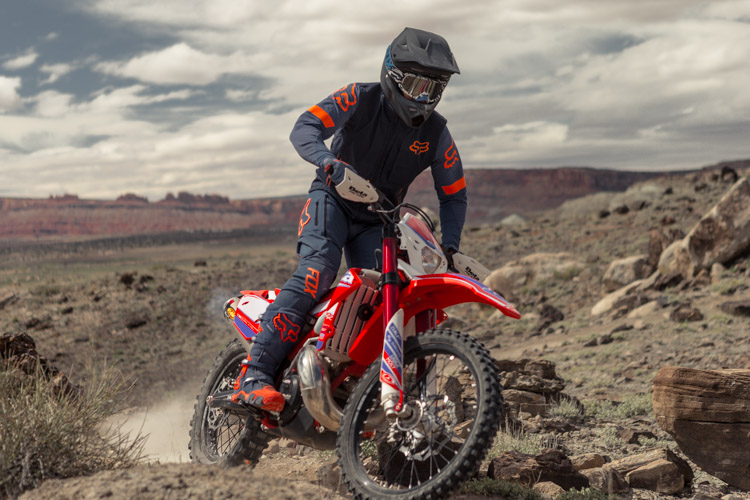Photos by Drew Ruiz, Jimmy Lewis, Heather Lewis
Two-Strokes Evolved
Beta 300 RR Race Edition $8899 vs KTM 300 XC-W $9099

There are a lot of riders very fond of two-strokes. Some even fanatical. And in the off-road segment and the increasing popularity of more extreme type events and the riding styles this fosters, the 300cc two-stroke is the weapon of choice. Even if hitting intermediate level single track is all you really want to do. The lightweight packages are powerful without the girth penalty a four-stroke typically brings. Not to mention the more simplistic maintenance and lower cost from purchase to rebuild time. Two strokes are evolving and here to stay. Dirt Bike Test took two of the power players in this game to see where the dust settles.

-Both KTM and Beta are committed to the two-stroke and these bikes are very familiar yet also on the path to the future. The KTM is all-new bike in 2017 and in the transition stage to going to non-carbureted fuel delivery method starting in 2018 with carbs being phased out as soon as KTM feels the performance is better on each brand segment. KTM is constantly changing and updating its bikes and a leader in innovation and motorcycle progression. Beta’s design has been around for a while and is proven and improved–a lot. We suspect Beta have some big changes in the works but the always conservative company would rather follow and refine than pioneer new bold territory. Unless you count the re-introduction of oil-injection but as good as that is, it was anything but new.

-For 2017 KTM’s all-new two-stroke motor has one big addition that is a game-changer in recent two-stroke times. A counterbalancer. This small and thoughtful addition makes more difference than you can imagine. Till you ride any other non-counterbalanced two-stroke, especially a 300cc one. It is the first thing any rider said when switching between these two bikes. And that Beta does not vibrate that much! The shakes you feel in the handlebar and through the footpegs is reduced by a solid 75% if we were to put a number to it. Some riders noticed it more than others, some cared more than others. But no matter what this can not be ignored from the shakes alone. And we noticed some other advantages as well, more later.

-The weight is an area where the scale will tell you one thing and riding the bikes will tell you another. The 224 with no fuel and 239 with a full tank of gas, the KTM is very light on the scale but depending on how you ride, may not feel that light in use. At 236 empty and 249 full, the Beta might scare a few of the weight watchers away. But if you ride and steer the motorcycle with more weight on the pegs the Beta can feel as light if not lighter on its wheels than the KTM. The more you push on the bars the lighter the KTM will feel to you. The Beta actually has a lighter handlebar steering feel and if you let the bars stay light, they act very light. Yet no matter what you do if the bikes start getting wild and either thrown around on purpose or getting out of control, the lighter KTM feels more nimble here. Don’t know what that feels like? Don’t worry, picking them up off the ground gives the same impression. 20 pounds is still 20 pounds and in moving the bikes around, without power (loading, unloading, off of a workstand) they Beta feels 20 pounds heavier. We’d need a person with a degree in engineering to explain all this to us but we know what we feel. Yet compared to even 250cc four-strokes these bikes feel very light. And they also stay comparatively light as the power and RPM increases.

-300cc two-strokes are all about power and both of these bikes deliver in spades. The roll-on of the two-stroke in this displacement is what they are all about. From just about any running speed just opening the throttle will yield a very quick acceleration above what the sound of the engine tells you. There is forward propulsion that has a raw torquey tug that feels like there is a rubber band pulling you along assisting the engines on both bikes. Each have a full spread of power that resists spinning up suddenly but also has a burst of power available with a touch of the clutch. Which is quicker? Every rider felt the Beta was faster. Until you put the bikes side-by-side and the KTM out accelerates, pulls in roll-ons or beats the Beta in drag races in every condition. (our KTM has JD jetting kit installed in the Mikuni carb and it does make the bike run better than stock, with stock jetting the bikes would be a little closer since the KTM does not pull as clean off the bottom in stock configuration.) It is about a bike length in any battle or about the equivalent of 35 pounds in rider weight. And why did the Beta feel faster? We have a couple of answers. The extra vibration makes it feel more aggressive or racey. And the Beta has more distinct powerband characteristics. Off the very bottom it is smoother and torquier with flywheel-type stalling resistance and then a bigger top-end surge compared to its flatter mid-range. We would call it a more progressive power build in comparison to a very linear KTM. Which is better? Depended on the preference of the rider.

-On the suspension front it is surprisingly close too. This is a shock because just a few years ago the Beta was not even in the game. But it has come a lot farther that we could have imagined with similar Sachs components. They are way more dialed in and internally Beta have made changes to fight the fading and wear issues of the past. The shock has much better damping control and the fork is so much more supple than in the past. The RR starts out just a little stiffer in nature than the KTM XCW but isn’t quite as progressive. Both forks never run into any issues with the KTM’s open cartridge system being a more simplistic design, but KTM has upped the game with their WP unit. Most of our testers were happy right away with the feeling of the KTM suspension and liked the added bottoming resistance on both ends compared to the Beta. We have since added a little oil to the Beta fork and it improved to the point we want a little more progression in the shock for our Western conditions. Even in the slower and more technical conditions the KTM tends to shine a little more in how active and supple the fork and shock move, even compared to running the Beta with a lighter compression setting. Let any rider get comfortable on one of the bikes and then the other one is easy to pick apart after a short riding stint. Both are very suited to the endgame of being single-track race bikes or capable trail weapons.

-Is the linkage better than the PDS? Some riders went in convinced they would not like PDS and were surprised at the KTM’s progression in the stroke. One thing was that setting the ride height on both bikes was pretty critical but for different reasons. When the Beta gets low in the stroke it’s handing really suffers and it high, it becomes unstable. The KTM either packs or blows through the stroke if the ride height is off. Picky riders will spend more time making changes to the KTM’s PDS shock for changing conditions compared to the linkage system on the Beta.

-The Beta feels more roomy and spread out that the KTM and without needing to move the handlebars into a forward position. Yet it is easy to change the footpegs on the KTM to a slightly lower position which has helped for our taller riders.

-Onto the little things and each brand has some gems up its sleeve. KTM has an awesome air filter design that is easy to service. But it also is much less happy in deep water crossings too. The Beta RR does not have the electronic oil injection which we liked so much on the standard edition, but in the name of racing and a little weight it isn’t on the RR. Both bikes have adjustable powervalves and both work wonders in tuning the power. And the Keihin Carb on the Beta is much less fussy and only took a needle clip change to go from sea level to 8000 Ft.

-When you pick these bikes apart it is easy to say the KTM is a better machine in every department. But the difference is much less than before, much less that most riders imagined before riding both bikes and is much less than a spec sheet will show. But the standout thing and the biggest difference (besides the color) is that the KTM vibrates less.




15 Responses to “This Or That: Beta 300 RR vs KTM 300 XC-W”
Jesse P Weaver
At 236 empty and 249 full, the Beta might scare a few of the weight watches away.
Watches should probably be watchers.
Jimmy Lewis
Thanks Jesse!
arthur pappas
Thanks for the review, Jimmy. Certainly feels like we’re on the doorstep of innovation for off-road bikes, what with counter-balancers, oil injection, fuel injection, air forks, etc. I’d imagine Gas Gas, Beta, and Sherco will quickly adopt most (if not all) of the current KTM engineering advances. Will be interesting to see Yamaha’s response — I hope it’s not BNG…
The 2019 (or maybe 2020) 2-stroke shoutout is gonna be epic!
Jimmy Lewis
Thanks for the catch. Impression has been updated with information yet the feeling on the bike has not changed…
Jimmy Lewis
Mark,
The KTM was as stock as they come. And trust us we used every gear. Plus we had a very wide range of riders on both bikes and the impressions were very consistent. We are praising both suspension setups here and the Beta is VERY much improved. But we are looking into some of the chassis changes that might be at the root of this felling.
Mark Crotts
Thanks for your reply. After owning 25 ktm i dumped them in 2014 because of the 4cs joke wp dumped on us. I saw the former ktm quality going down the tubes. Because of your reports I’m currently riding a beta 300 race and a Yamaha 450fx. Both are superior to any ktm I’ve owned in the past. Thanks for your honesty.
Mark Crotts
Get Outlook for Android
Jimmy Lewis
Thanks for the info. I cleaned up the impression to explain it better. Besides, being a fast washed up ex-motorcycle racer means math comes second…
Jimmy Lewis
I’m gonna make more mistakes in the future just to get all you guys pointing it out and paying attention! Thanks for keeping us on our toes. We are still working on the full test of the Beta so in reality I had not dug through the spec sheet just yet. We only blame things when they don’t work up to standards. The Beta for is good no matter what is inside!
Robert Moore
Great comparison guys. Rode the Beta 250RR Race Edition last year and really enjoyed it. Ended up getting a KTM 250 XC-W cause of terrible service from the local Beta importer. Took some work to get the KTM to where I was 100% happy with it, but I don’t regret going KTM at all
Jimmy Lewis
Robert,
Are you in the US? Or do you mean dealer? Just curious.
Robert Moore
I’m in South Africa. The importer here is also the main dealer. They’ve managed to kill several brands locally
Robert Moore
Nope, I’m from South Africa. The importer and dealer are the same company here. They’ve managed to drag a few brands into the mud with their shady practises
Jimmy Lewis
Thanks for the insight. Real riders from the community only help us improve our information and tell us what is important to you guys.
Johnny Depp
It’s interesting that you picked up on something about the weight, the scale doesn’t tell the story when you are riding. I have suspicions that the extra rotating mass of the counterbalancer has much the same effect as the valve train on a 4 stroke. You feel it.
It would be interesting if you would post your best suspension settings since many are searching for good info and you guy’s are the pro’s.
Jimmy Lewis
Weight feel is much different than what the scale says. I’m pretty sure that is what you are confused about.